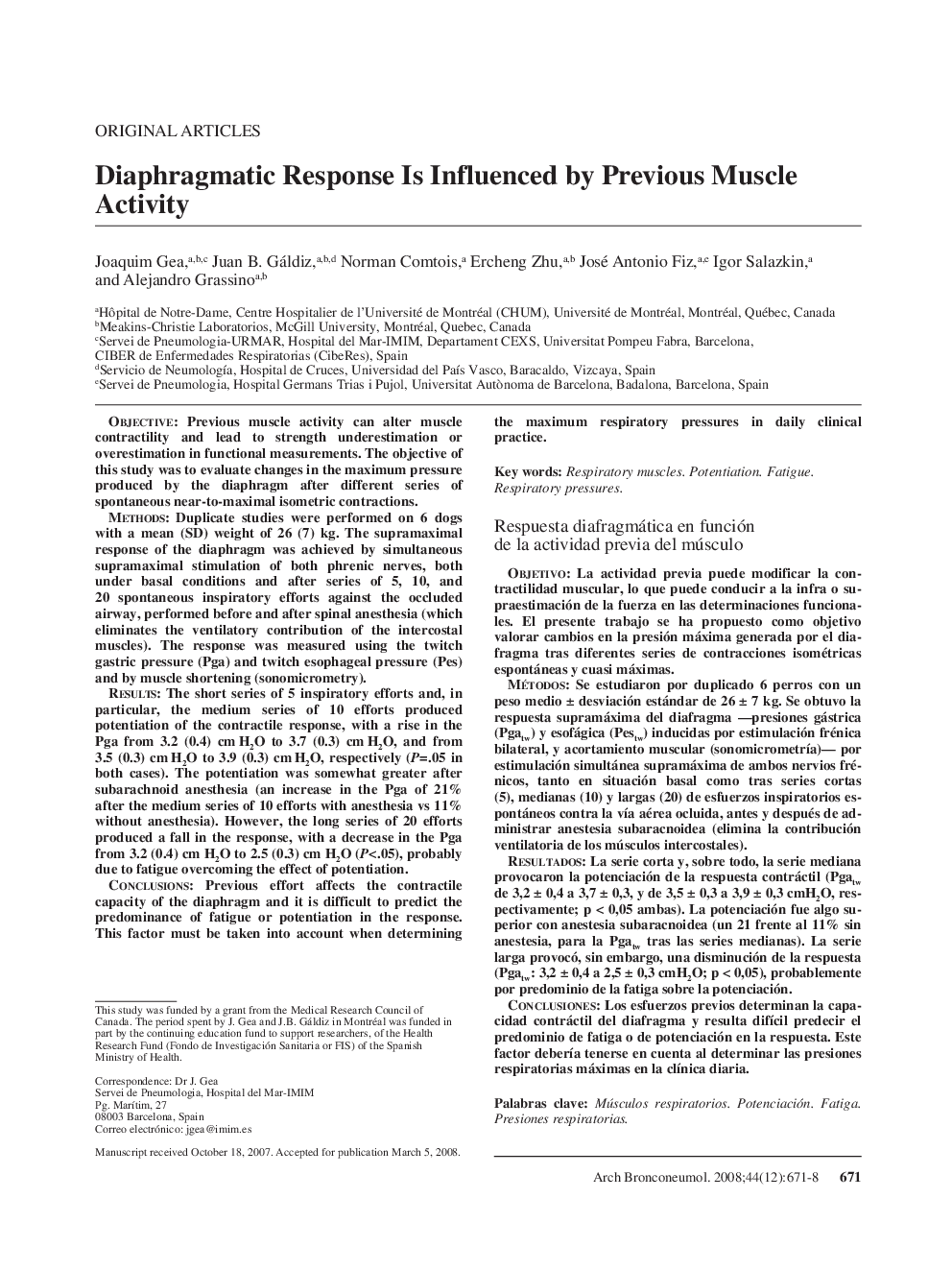| کد مقاله | کد نشریه | سال انتشار | مقاله انگلیسی | نسخه تمام متن |
|---|---|---|---|---|
| 4206189 | 1279965 | 2008 | 8 صفحه PDF | دانلود رایگان |

ObjectivePrevious muscle activity can alter muscle contractility and lead to strength underestimation or overestimation in functional measurements. The objective of this study was to evaluate changes in the maximum pressure produced by the diaphragm after different series of spontaneous near-to-maximal isometric contractions.MethodsDuplicate studies were performed on 6 dogs with a mean (SD) weight of 26 (7) kg. The supramaximal response of the diaphragm was achieved by simultaneous supramaximal stimulation of both phrenic nerves, both under basal conditions and after series of 5, 10, and 20 spontaneous inspiratory efforts against the occluded airway, performed before and after spinal anesthesia (which eliminates the ventilatory contribution of the intercostal muscles). The response was measured using the twitch gastric pressure (Pga) and twitch esophageal pressure (Pes) and by muscle shortening (sonomicrometry).ResultsThe short series of 5 inspiratory efforts and, in particular, the medium series of 10 efforts produced potentiation of the contractile response, with a rise in the Pga from 3.2 (0.4) cm H2O to 3.7 (0.3) cm H2O, and from 3.5 (0.3) cm H2O to 3.9 (0.3) cm H2O, respectively (P=.05 in both cases). The potentiation was somewhat greater after subarachnoid anesthesia (an increase in the Pga of 21% after the medium series of 10 efforts with anesthesia vs 11% without anesthesia). However, the long series of 20 efforts produced a fall in the response, with a decrease in the Pga from 3.2 (0.4) cm H2O to 2.5 (0.3) cm H2O (P<.05), probably due to fatigue overcoming the effect of potentiation.ConclusionsPrevious effort affects the contractile capacity of the diaphragm and it is difficult to predict the predominance of fatigue or potentiation in the response. This factor must be taken into account when determining the maximum respiratory pressures in daily clinical practice.
ObjetivoLa actividad previa puede modificar la contractilidad muscular, lo que puede conducir a la infra o supraestimación de la fuerza en las determinaciones funcionales. El presente trabajo se ha propuesto como objetivo valorar cambios en la presión máxima generada por el diafragma tras diferentes series de contracciones isométricas espontáneas y cuasi máximas.MétodosSe estudiaron por duplicado 6 perros con un peso medio ± desviación estándar de 26 ± 7 kg. Se obtuvo la respuesta supramáxima del diafragma —presiones gástrica (Pgatw) y esofágica (Pestw) inducidas por estimulación frénica bilateral, y acortamiento muscular (sonomicrometría)— por estimulación simultánea supramáxima de ambos nervios frénicos, tanto en situación basal como tras series cortas (5), medianas (10) y largas (20) de esfuerzos inspiratorios espontáneos contra la vía aérea ocluida, antes y después de administrar anestesia subaracnoidea (elimina la contribución ventilatoria de los músculos intercostales).ResultadosLa serie corta y, sobre todo, la serie mediana provocaron la potenciación de la respuesta contráctil (Pgatw de 3,2 ± 0,4 a 3,7 ± 0,3, y de 3,5 ± 0,3 a 3,9 ± 0,3 cmH2O, respectivamente; p < 0,05 ambas). La potenciación fue algo superior con anestesia subaracnoidea (un 21 frente al 11% sin anestesia, para la Pgatw tras las series medianas). La serie larga provocó, sin embargo, una disminución de la respuesta (Pgatw: 3,2 ± 0,4 a 2,5 ± 0,3 cmH2O; p < 0,05), probablemente por predominio de la fatiga sobre la potenciación.ConclusionesLos esfuerzos previos determinan la capacidad contráctil del diafragma y resulta difícil predecir el predominio de fatiga o de potenciación en la respuesta. Este factor debería tenerse en cuenta al determinar las presiones respiratorias máximas en la clínica diaria.
Journal: Archivos de Bronconeumología ((English Edition)) - Volume 44, Issue 12, 2008, Pages 671-678